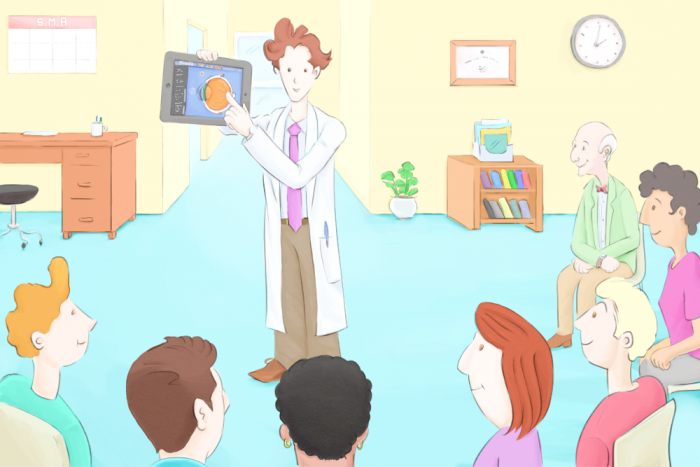What if there were a way to give patients more of your time and attention while also giving them the opportunity to learn better health habits from their peers? There is, and it’s called the shared medical appointment. The concept is catching on with both doctors and patients, since it can reduce the cost of care while improving the patient experience. Read on to find out what a shared medical appointment is, what it is not, and whether this may be one way to address the changing U.S. health care system’s needs.
Gaining in popularity
Shared medical appointments (SMAs), also known as group visits, are not new. Many providers have made them available to patients for years, including Cleveland Clinic, which has been offering SMAs since 1999. Common for patients managing chronic conditions such as diabetes or asthma, group visits are ideal for addressing health issues that require a certain amount of patient education and self-management. The popularity of SMAs has been increasing as health care costs rise and the length of the typical doctor’s visit shrinks.
From 2005 to 2010 the percentage of practices offering group visits doubled, from 6 percent to 13 percent, Time magazine reported in 2013. And according to the American Academy of Family Physicians (AAFP), an estimated 10 percent of family doctors offered shared medical appointments in 2015. Data on group visits in other medical specialties is harder to come by, but experts say an increasing number of health care providers are offering group visits.
“A typical doctor’s visit might last 15 to 20 minutes and involve one patient and one doctor. Shared appointments, on the other hand, often last around 90 minutes, and it’s not uncommon for 10 patients to see the doctor during that same appointment,” according an article in U.S. News & World Report.
The AAFP states on their web site: “group visits are a proven, effective method for enhancing a patient’s self-care of chronic conditions, increasing patient satisfaction, and improving outcomes.”
How SMAs work
Let’s clear up some common misconceptions about shared medical appointments. First, they are voluntary for patients. Second, they are not the same as support groups or group therapy, because doctors provide hands-on care during SMAs, such as blood pressure checks or physical exams. They also may write prescriptions or perform other functions they would during one-on-one visits with patients.
Privacy is another common concern, say doctors who offer SMAs. However, participants must sign waivers agreeing not to discuss other patients’ medical information outside of the group visit. And if a patient needs a more thorough evaluation or needs to disrobe, that is done in private. Interestingly, in one study of SMAs involving ENT patients, participants were given the option of having their focused ear, nose, and throat exams in an open room or in a private exam room; none of the participants opted for the exam room.
Shared medical appointments also include counseling and educating the patients as a group. Proponents believe that this benefits patients in many ways. SMAs “provide a secure but interactive setting in which patients have improved access to their physicians, the benefit of counseling with additional members of a health care team (for example a behaviorist, nutritionist, or health educator), and can share experiences and advice with one another,” states the AAFP.
Improving patient education and satisfaction
There is evidence that patients benefit from SMAs with their peers. They may feel validated or inspired by others who share their experiences, and they often pick up new information from other patients who ask questions they forgot or didn’t think to ask, say providers who offer group visits.
Research confirms this. Shared medical appointments “improved physiologic health, self-efficacy, and patient education and feasibility…” according to the results of a pilot program in a private otolaryngology practice, published in The American Journal of Managed Care (AJMC) in July 2016.
“Patient satisfaction with SMAs has been found to be high,” the researchers noted. Group visits appeared to particularly benefit patients “whose chronic condition requires more education regarding their diagnosis, health status, and disease self-management,” such as chronic rhinosinusitis, which results in over 18 million patient visits annually in the U.S., incurring between $3 billion and $5 billion annually in treatment costs.
The answer to controlling health care costs?
Some critics of SMAs worry that patients may feel pushed into them by health providers or HMOs focused on the bottom line, reports U.S. News & World Report. However, proponents insist that SMAs are meant to supplement what the patient is already receiving from their provider. And, if doctors can improve the quality of care and the patient experience while at the same time reducing the cost of care, why wouldn’t they? Additionally, advocates point out that neither patients nor providers have anything to lose by trying a new model of patient care.
Given that the entire U.S. health system is shifting away from the traditional model of patient care and considering new ways to manage chronic conditions, “providers must reconsider how they deliver care in order to balance efficiency, cost, and quality at a time when there is increasing competition for health care dollars,” wrote the ENTs who piloted the SMA program in the AJMC. “The shared medical appointment is one model of care that holds promise for achieving these goals.”
For more articles like this, subscribe to our newsletter today.

